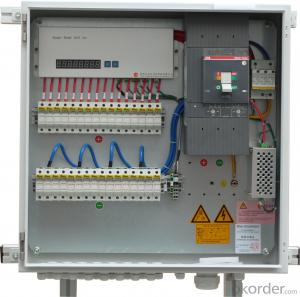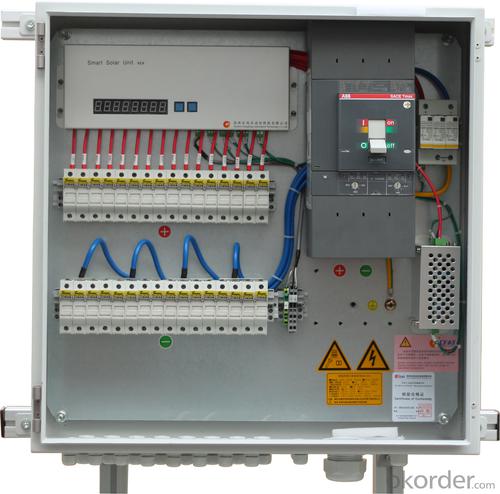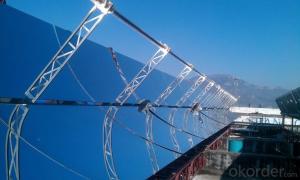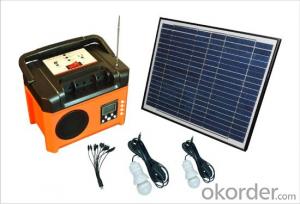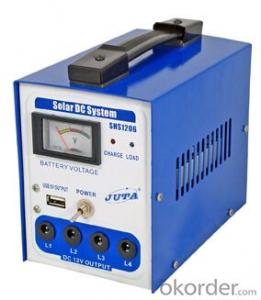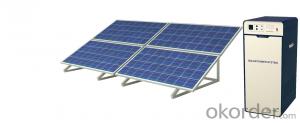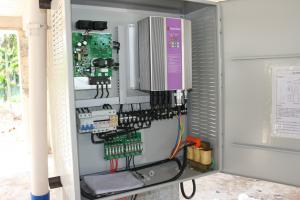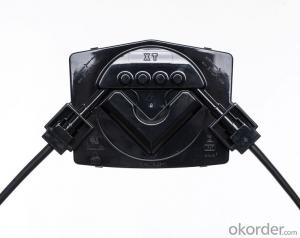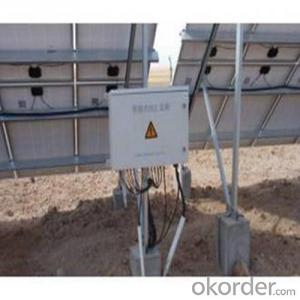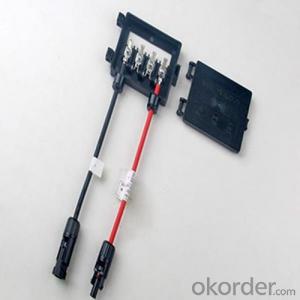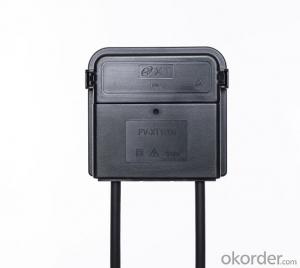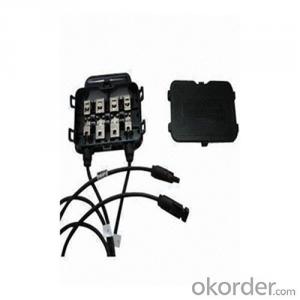Solar Energy Systems 101:TüV Certified PV Combiner Box
- Loading Port:
- Shanghai
- Payment Terms:
- TT OR LC
- Min Order Qty:
- -
- Supply Capability:
- 2000 set/month
OKorder Service Pledge
OKorder Financial Service
You Might Also Like
Company Profile
We are derived from an aviation factory , and it has the registered capital of 12million and is located in the Suzhou Industrial Park which is top of the world.That is the park where the world top enterprises are gathered and generated.
We aer the key new energy company supported by the park ; it is the onlycompany specialized in research and development of the China Photovoltaic Combiner Box and with independent intellectual property rights.
The fifth generation of Photovoltaic CombinerBox with real-time synchronous and multiple-access digital transmission , andDC arc detection is doing to be generated from the production line of Suzhou Changfeng Automation Technology Co.,Ltd.
Our business model: self-owned brand products marketing and ODM/OEM.
We will only produce the most safe Photovoltaic Combiner Box of the world.
CFAT PV CombinerBOX technicalfeatures
International excellent quality
1, the firstcertified by UL structure
2, Passed the TÜV / CE / CQC certification
Independent intellectual property rights
1,With 27 patents, wherein 10 of them are patents for invention
2,Passes the High-tech Product Certificate of Jiangsu province
Product advantages
Safe UL V0 levelinflaming retarding will definitely not catch fire
Reliable Theresearch process adopts the military standards of aviation
Durable 25 yearsof quality assurance, 5 yeas of “three guarantees” (for repair replacement orcompensation of faulty products) of products and 10 years of the box bodyguarantee can be provided
Product features
1、 Convenient: the 8th loop to the 16th loop are the same boxes withthe size of 600*600*210
2、 Solid: the material of the box is high-quality hot dip galvanizedplate, painted with outdoor toner, which will never fade and fall off
3、 Durable: 25years of quality guarantee, be able to adapt to theenvironment temperature of -30-70℃ and humidity 0-99%(without dew formation), and the protection gradeis higher than IP65
4、 Safe: UL V0 level inflaming retarding will definitely not catch fire
5、 Stable: the unique heat balance technology with the specialinternational excellent parts that meet the UL DC 1000V standards
6、 Advanced: computer aided design, embedded system, local/remote monitoringaccurate measurement
- Q: Can solar energy systems be used for powering recreational vehicles or boats?
- Certainly, solar energy systems can be utilized to power recreational vehicles (RVs) and boats. The utilization of solar power is gaining popularity within the RV and boating communities due to its various advantages. The installation of solar panels on the roofs of RVs and boats enables the absorption of sunlight and its conversion into electricity. This electricity can then be employed to power various appliances and systems on board, such as lighting, refrigeration, air conditioning, and even device charging. The primary advantage of employing solar energy for RVs and boats is that it provides a clean and renewable source of power. By harnessing the energy of the sun, users can significantly reduce or eliminate their dependency on conventional fossil fuel generators. This not only aids in diminishing carbon emissions and minimizing environmental impact but also leads to long-term savings on fuel expenses. Moreover, solar power systems are highly adaptable and can be customized to meet the specific energy requirements of RVs and boats. They can be designed to be easily portable and deployable, allowing users to take advantage of solar energy wherever they travel. Furthermore, advancements in solar technology have improved the efficiency and durability of panels, ensuring reliable power generation even in adverse weather conditions. It is crucial to carefully consider the size and capacity of the solar energy system to meet the energy needs of the RV or boat. The number of solar panels and batteries required will depend on factors such as the size of the vehicle or vessel, energy consumption, and desired level of self-sufficiency. In conclusion, solar energy systems present a viable and sustainable option for powering recreational vehicles and boats. They offer numerous benefits, including reduced reliance on fossil fuels, cost savings, and environmental friendliness. With advancements in technology, solar power is becoming increasingly accessible and efficient, making it an attractive choice for those seeking to power their RVs or boats with renewable energy.
- Q: Can solar energy systems be used in areas with high levels of air pollution from wildfires?
- Yes, solar energy systems can still be used in areas with high levels of air pollution from wildfires. While air pollution from wildfires can reduce the efficiency of solar panels by blocking sunlight and reducing the amount of energy they generate, it does not render them completely useless. Solar panels can still generate electricity even in partially shaded conditions, although their output may be reduced. Additionally, advancements in solar panel technology have made them more resilient to various environmental factors, including smoke and dust particles. Furthermore, solar energy systems can still prove to be a valuable source of electricity during and after wildfires when power outages are common. Therefore, while air pollution from wildfires may affect the performance of solar energy systems to some extent, they can still be used effectively in these areas.
- Q: Can solar energy systems be used in powering movie theaters or entertainment venues?
- Certainly, movie theaters and entertainment venues can absolutely utilize solar energy systems to provide power. The operation of these venues requires a substantial amount of electricity for their lighting, sound systems, projectors, and other equipment. Solar energy systems have the ability to generate clean and renewable electricity by harnessing the sun's power. By installing solar panels on the roofs or in the surrounding areas of these venues, they can generate a significant amount of electricity to fulfill their energy requirements. Not only can solar energy systems be designed to supply power for the basic infrastructure of movie theaters or entertainment venues, but they can also support additional energy-intensive features such as HVAC systems, concession stands, and even electric vehicle charging stations. By utilizing solar energy, these venues can greatly reduce their dependence on grid electricity, decrease operational expenses, and contribute to a more sustainable and environmentally friendly future. Besides the practical advantages, the installation of solar energy systems in movie theaters or entertainment venues can also serve as a demonstration of environmental responsibility and attract environmentally conscious audiences. Many individuals are becoming increasingly aware of the significance of renewable energy, and by showcasing their commitment to sustainability, these venues can enhance their brand image and appeal to a wider customer base. In conclusion, the utilization of solar energy systems to power movie theaters or entertainment venues is not only technically viable but also financially and environmentally beneficial. By harnessing the sun's power, these venues can diminish their carbon footprint, save on energy costs, and contribute to a greener future for the entertainment industry.
- Q: Can solar energy systems be used for powering electric vehicle research and development centers?
- Yes, solar energy systems can be used to power electric vehicle research and development centers. Solar panels can generate electricity from sunlight, which can be used to power the facilities and provide a sustainable and renewable energy source for the centers' operations. This can greatly contribute to reducing carbon emissions and promoting green and clean energy practices in the electric vehicle industry.
- Q: Can solar energy systems be used in areas with limited water resources?
- Yes, solar energy systems can be used in areas with limited water resources. Unlike other forms of energy generation such as fossil fuels or nuclear power, solar energy systems do not require significant amounts of water for their operation. Solar panels convert sunlight directly into electricity without the need for water cooling or steam generation, making them suitable for use in arid regions or areas facing water scarcity. This makes solar energy a sustainable and viable solution for electricity production in areas with limited water resources.
- Q: Can solar energy systems be integrated into building materials, such as solar roof tiles?
- Solar energy systems can indeed be incorporated into building materials, and one popular instance of this is the utilization of solar roof tiles. These tiles, also referred to as solar shingles or solar slates, have been meticulously designed to resemble conventional roofing materials while simultaneously harnessing solar energy. Constructed with photovoltaic cells that convert sunlight into electricity, these specialized tiles have numerous advantages over traditional solar panels. One of the primary benefits of solar roof tiles is their seamless integration with a building's overall aesthetics, resulting in a more visually appealing structure. This harmonious blend into the building's structure allows for a more cohesive design, particularly in regions where stringent architectural guidelines are in effect. Moreover, solar roof tiles can be installed on both new and existing buildings, providing a flexible and adaptable solution. Another advantage of solar roof tiles lies in their ability to generate electricity while exhibiting durability and resistance to harsh weather conditions. These tiles are specifically designed to withstand various elements, including rain, snow, and wind. Additionally, solar roof tiles are typically manufactured using high-quality materials, ensuring a longer lifespan compared to traditional roofing materials. The integration of solar energy systems into building materials, exemplified by solar roof tiles, offers a multitude of benefits. Not only do they generate clean and renewable energy, but they also contribute to reducing reliance on fossil fuels and decreasing carbon emissions. Additionally, solar roof tiles can assist in reducing energy costs by generating electricity on-site, enabling homeowners and businesses to achieve greater energy independence. In summary, solar energy systems can indeed be incorporated into building materials, and solar roof tiles serve as a prime example of this. With their visually appealing appearance, durability, and capacity to generate energy, solar roof tiles present a promising solution for harnessing solar power while simultaneously preserving the architectural integrity of a building.
- Q: Can solar energy systems be used for powering remote monitoring equipment?
- Yes, solar energy systems can be used for powering remote monitoring equipment. Solar energy systems use photovoltaic (PV) panels to convert sunlight into electricity, which can then be used to power various devices and equipment. Remote monitoring equipment, such as weather stations, surveillance cameras, or communication systems, can be easily powered by solar energy systems. These systems are particularly useful in remote or off-grid locations where access to electricity may be limited or non-existent. Solar energy is a sustainable and renewable source of power, making it an ideal choice for powering remote monitoring equipment without relying on fossil fuels or traditional electrical grids. Additionally, solar energy systems can often be combined with battery storage to provide continuous power supply even during periods of low sunlight.
- Q: What is the impact of solar energy systems on air quality?
- Solar energy systems have a positive impact on air quality as they produce electricity without emitting harmful pollutants or greenhouse gases. By reducing the reliance on fossil fuels, solar energy helps to mitigate air pollution, improve public health, and combat climate change.
- Q: Can solar energy systems be used for powering off-grid disaster response teams?
- Yes, solar energy systems can be used for powering off-grid disaster response teams. Solar panels can generate electricity from sunlight, providing a reliable and sustainable source of power in areas where the traditional grid is unavailable or disrupted due to a disaster. This enables disaster response teams to operate critical equipment, communication systems, and medical facilities, ensuring effective response and aid delivery in these challenging situations.
- Q: How much energy can a solar energy system produce?
- The amount of energy that can be generated by a solar energy system relies on a variety of factors, including the system's size, efficiency, location, weather conditions, and available sunlight. On average, a typical solar energy system can produce between 1 and 10 kilowatt-hours (kWh) of electricity per day for every installed kilowatt (kW) of solar panels. To illustrate, a solar energy system with a capacity of 5 kW can generate approximately 5 to 50 kWh of electricity daily, which is typically sufficient to fulfill the energy needs of an average household. However, it is important to note that this energy production can fluctuate throughout the year due to seasonal changes in sunlight availability and weather conditions. Furthermore, advancements in solar technology and enhanced efficiency of solar panels have resulted in significant improvements in energy production. By utilizing high-performance solar panels and optimized system designs, it is possible to generate even greater amounts of electricity, thereby maximizing the energy output of a solar energy system. Moreover, any surplus energy generated by a solar energy system can be stored in batteries for future use or fed back into the power grid, depending on the specific setup and local regulations. This enables further utilization and optimization of solar energy production. Ultimately, the potential energy production of a solar energy system is a dynamic and customizable aspect that can be adjusted to meet individual energy requirements and objectives. Seeking guidance from a solar energy professional can provide more precise estimates and assist in designing a system that is best suited to specific needs.
Send your message to us
Solar Energy Systems 101:TüV Certified PV Combiner Box
- Loading Port:
- Shanghai
- Payment Terms:
- TT OR LC
- Min Order Qty:
- -
- Supply Capability:
- 2000 set/month
OKorder Service Pledge
OKorder Financial Service
Similar products
Hot products
Hot Searches
Related keywords
